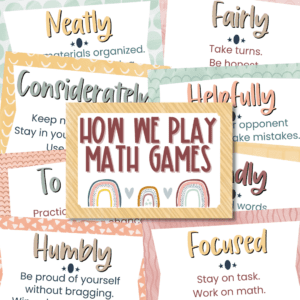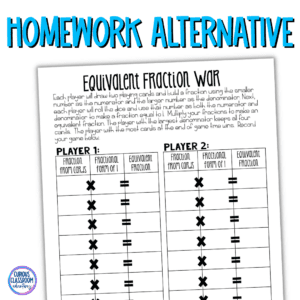Games are a great way to engage students and help them learn. This is especially true for math games. Math games can be used in a variety of ways to reinforce skills, review before assessments, and provide an alternative to homework. Here are a few outside-the-box ways to use math games in the classroom–plus a free download of math games behavior expectation posters to keep game time running smoothly.
Math Assignment for the Day:
One of the ways to use math games is to make it the math assignment for the day. A well-designed math game (like these) will require just as much targeted math practice as a worksheet, if not more. Substitute the math game recording sheet for the workbook page, and your students will think you’re rewarding them with a treat!
Early Finishers:
Got a few early finishers? This is one of my favorite ways to math games–the perfect solution for early finishers. Keep a stash of math games on a shelf and pull them out when kids finish their work early. This will give them something to do that is productive and educational. And it will save you from having to come up with something on the fly!
Homework Practice:
Next on our list of ways to use math games will turn into a kid favorite! Instead of assigning traditional math homework, mix things up and have kids play a math game at home. This could be as simple as playing. The key is to make it fun so that kids are actually excited to do their “homework.”
I like to send home the game instructions and a recording sheet on Monday that students are required to turn in by Thursday. This gives families a chance to choose a time that works best for them and it allows parents to really see how well their kids understand the math skill involved with the game.
Stations:
Math stations are a great way to differentiate instruction and allow students to work at their own pace. There are so many ways to mat games in various stations. Computer math games can be used as part of your technology station. Multiplication fact games keep kids on task at the fact fluency stations. And of course, you’ll need games at your math games station!
Students can play the game for a set amount of time and then rotate to the next station. Plus, these are easy ways to use math games in your daily routine without having to rework your entire lesson plan.
Review before Assessment:
One of the most tried and true ways to math games is for a fun review before an assessment. This is a great way to get students engaged and help them relax before a test. Plus, it gives your students a chance to show what they know in a low-stress environment.
Indoor Recess:
We all know that sometimes indoor recess is a necessary evil. When it is time to head inside, break out some math games to keep kids engaged and learning. These don’t have to be complicated games; simple card games or dice games will do the trick. Not only will kids stay engaged, but they might even have some fun!
There you have it—6 of my favorite ways to use math games in the classroom. Give one (or all!) of these ideas a try and see how they work for you and your students and let me know how it works out!





